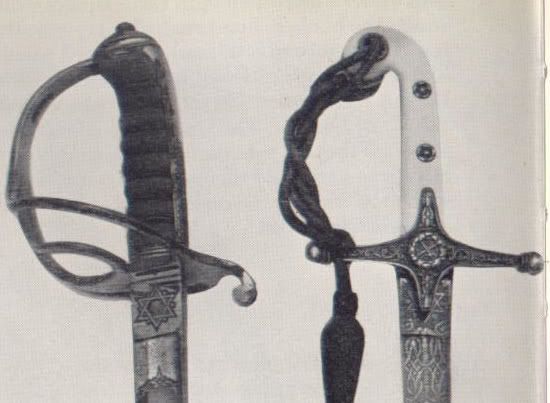
 |
|
|
|
|
#1 |
|
Member
Join Date: Jun 2006
Location: Arabia
Posts: 278
|
Hi,
I just got these pics from a friend who would like to sell this sword. I thought I would show you the pics, just for sharing though. I would also like to know what you think. I think that the blade is european, locally etched. The marks on the blade are the most interesting thing about it. There are some amharic words on it, which would mean an ethiopian provenance, but we never knew that these swords were found in ethiopia (I think)?! There is also a star of david sign on the forte, which would mean that this sword belonged to a jew, which would be reasonable as there were many jews in ethiopia and Yemen. This could also be an Ethiopian blade remounted in Yemeni fittings. |
|
|

|
|
|
#2 |
|
Member
Join Date: Jun 2006
Location: Arabia
Posts: 278
|
A couple more:
|
|
|

|
|
|
#3 |
|
(deceased)
Join Date: Dec 2004
Location: East Coast USA
Posts: 3,191
|
The blade seems to be from an Ethiopian saber it may not be original to the hilt? The scabbard seems to be Ethiopian made also?
Lew |
|
|

|
|
|
#4 | |
|
Keris forum moderator
Join Date: Aug 2006
Location: Nova Scotia
Posts: 7,124
|
Quote:
http://www.marines.com/page/usmc.jsp...hRedirect=true |
|
|
|

|
|
|
#5 | |
|
Member
Join Date: Dec 2004
Location: Virginia
Posts: 520
|
I was under the impression that most of the saif with the ring on the hilt like this came from near Dar es Salaam or Zanzibar. So if this is from Ethiopia it would be an interesting find. I want to say I have seen similar markings on a gurade ( and Gurade is the amharic word for sword ) I will look and see if I can find it again.
Maybe Mark or Jim will chime in on this, in another place Mark stated this about ethiopian blades Quote:
And I have been told there are Jambiya with Jewish blades so it would not be out of the realm of posibilities for there to be a Jewish blade in a saif Last edited by RhysMichael; 2nd February 2007 at 08:18 PM. |
|
|
|

|
|
|
#6 |
|
Member
Join Date: Dec 2004
Location: What is still UK
Posts: 5,807
|
S.Al. Anizi, an interesting turn round in questions. The star/seal of Solomon is used by Christians as a symbol of right/justice and wisdom as far as I know. These two British military swords carry the symbol and I am sure there is absolutely nothing to do with Judaism. Solomon features in a great deal of Ethiopian art as the Ethiopians hold that Sheba hails from thier own land. I have an Ethiopia painting depicting Solomon and Sheba doing some sort of biblical thing.

Last edited by Tim Simmons; 2nd February 2007 at 09:21 PM. |
|
|

|
|
|
#7 | |
|
(deceased)
Join Date: Dec 2004
Location: East Coast USA
Posts: 3,191
|
Quote:
Can you be more specific. What are Jewish blades  The story that I have heard from my Yeman friends is that most of the better silver work seen on the higher quality jambiya and swords were done by Jewish silversmiths dating back to the last century 1800-1950. I have not heard of any Jewish bladesmiths making swords or daggers in that part of the world. Lew |
|
|
|

|
|
|
#8 | ||
|
Member
Join Date: Dec 2004
Location: Virginia
Posts: 520
|
Quote:
Quote:
|
||
|
|

|
|
|
#9 |
|
Member
Join Date: Jun 2006
Location: Arabia
Posts: 278
|
Thanks for the replies, Louie, David, Rhys, and Tim. I must confess, I never really knew what the hexagram really stood for in any of the three faiths, Judaism, Christianity, and Islam, which they all used throughout history. I must also admit, that I know very little about Ethiopian ethnicity, culture, and symbols, which are one of the most interesting in the world. Thanks for the link and pointing that out David, very interesting to see a hexagram with a cross in the middle of it.
This blade is most probably European, made for the Ethiopian army, but found itself in Zanzibar or Yemen. I have seen many hexagrams on european sabre blades, especially wilkinson's, but never really understood what they stood for  As to Yemeni jews, they probably only worked in silver, their work being referred to as "ibri" by arabs, which means hebrew, and regarded as the best. |
|
|

|
|
|
#10 | |
|
Member
Join Date: Dec 2004
Location: B.C. Canada
Posts: 473
|
Quote:
Hi Saqr, The Wilkinson sword company started with the brass proof mark as a way of marking that their blades were superior. Other companies soon copied this practice. So Wilkinson started placing the hexagrams around their proof marks to differentiate themselves.That also was eventially copied. Jeff |
|
|
|

|
 |
|
|